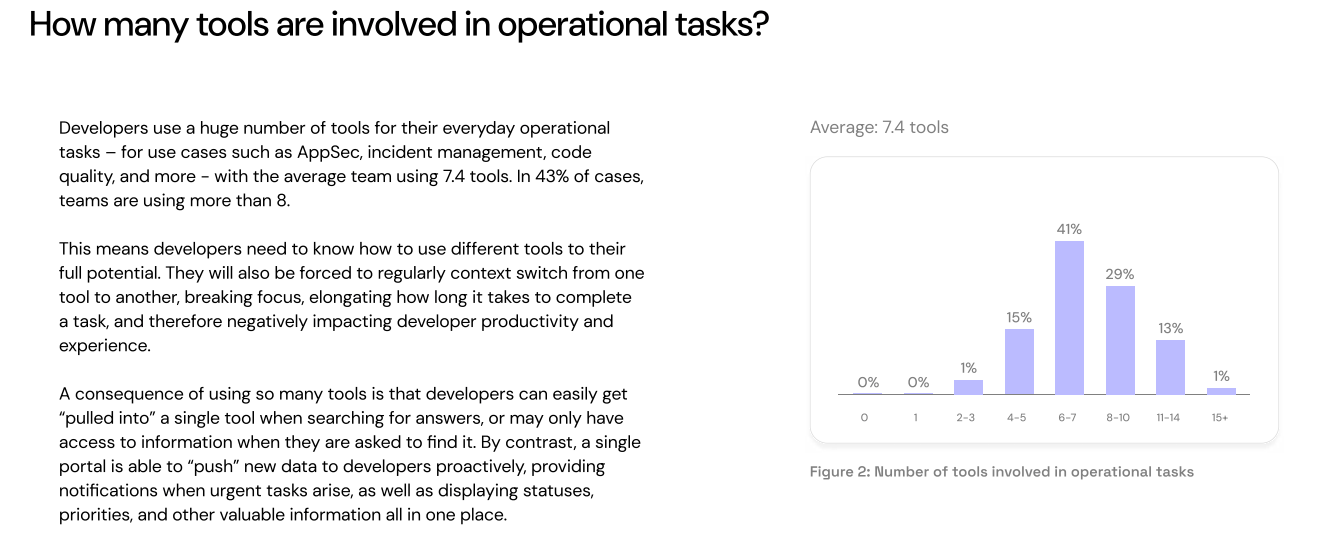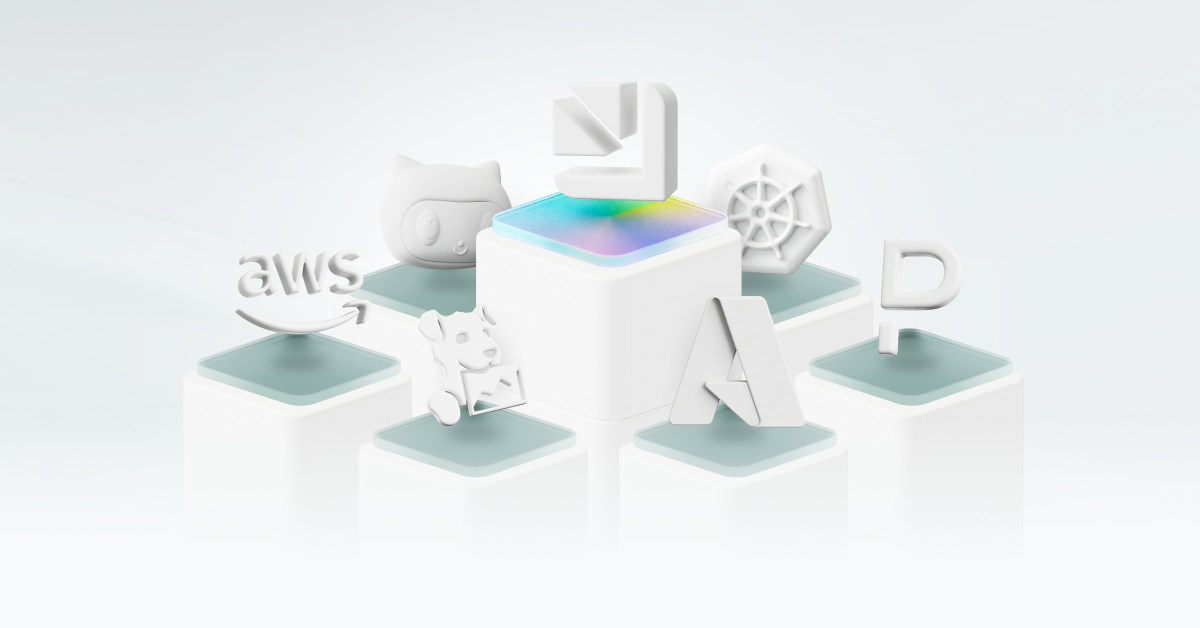When is the right time to adopt an IDP?
Organizations have to consider a lot of details before adopting an IDP, and it can be hard to know when is the right time.

When considering the adoption of an internal developer portal (IDP), it can be hard to know when you need to make the change. Even before taking action, there are a lot of organizational details to consider. However, many organizations face common challenges, pain points, and functional needs that make an IDP a practical, long-term solution to chaotic engineering environments.
In this article, we’ll cover some common reasons for adopting an IDP, and how IDPs like Port can help you solve organizational concerns across your software development lifecycle (SDLC).
DevOps comes before an IDP
Many organizations have multiple teams or business units that work on distinct products. Typically, each team uses different tools or products to manage their work. Some organizations may also have subsidiaries with their own tools or products that differ from other teams within the larger organization.
While this isn’t efficient, this structure can be dealt with until companies begin scaling, or have to consolidate tooling for budget reasons. At this stage, your organization may experience new pain points, like operational overhead and cognitive overload from dealing with and learning new tools.
When teams start struggling to define ownership of various tools, have multiple tools that do the same job, or lack a clearly-defined organizational hierarchy, you may realize you need to change. The desire to address these pain points is a sign it’s a great time to consider an IDP.
DevOps teams were initially tasked with solving these problems. Most businesses use DevOps best practices on their engineering teams, but the degree of tech stack standardization varies from one organization to another, which directly impacts developer experience (DevEx).
Platform engineering emerged later to address these standardization issues and create unified platforms that consolidated tooling, domain knowledge, and ownership details into a single place. By standardizing their tech stack, engineering organizations can improve DevEx, as well as engineering metrics and outcomes, just by cutting down on the time spent swapping tools and figuring out who owns what.
But a dedicated platform engineering team isn’t always a prerequisite for an IDP. Whoever builds your IDP should treat it like a product, and your developers as users; applying product management strategies to your portal build will help your organization get the most value from your IDP.
“When is the right time?” is also “What is the main value proposition?”
Another major reason to consider adopting an IDP is the biggest value it brings to your engineering teams. If your team has many multi-player processes in play — that is, multiple processes that involve multiple tools or systems and layers of approval from multiple stakeholders — you need something to orchestrate and manage those processes to avoid bottlenecks in your SDLC.
Whether your team is trying to manage resources or increase overall visibility, an IDP centralizes your developers and their tools, from AI agents to Kubernetes clusters, reducing costs without compromising on utility. Depending on your organization’s needs, some teams may need to maintain a few specialized modules or services outside of the IDP, but you can rely on the IDP for everything else. This has two benefits:
- It gives teams within your organization additional context on what everyone is doing.
- It cuts down on operational costs by eliminating duplicate tools that are more costly than what’s available within the IDP.

In Port specifically, Engineering Intelligence dashboards can give you an overview of tool usage to make sure your team adopts the tools built into the IDP, and you can run in-app surveys to gather qualitative feedback about tools or integrations from your developers. You can also use the Software Catalog to display which team members own which elements of your SDLC.
One Port customer, Aptos Retail, initially wanted to adopt an IDP to centralize their AWS accounts and Kubernetes clusters. They set out to understand and report on their assets, identify common concerns, and identify orphaned resources that could be cleaned up. While running a Proof of Value process, Aptos built out an integration that connected their S3 buckets to Port, and in doing so discovered an S3 bucket that:
- Was six years old,
- Was disconnected from any current services, and
- Cost them $30,000 a year.
By bringing your resources together in one IDP, you can identify what’s being used where — or what’s not being used, like in Aptos’s case — to manage resources and costs more effectively.
Unifying your tech stack is platform engineering’s primary job
Improving developer experience and engineering efficiency is the main purpose of platform engineering. But standardizing your tech stack improves DevEx in several ways: developers don’t have to swap contacts and tools all the time, and it becomes easier to measure engineering metrics because you have one system that sees everything your organization does, instead of seven or eight discrete systems.
If platform engineering’s main job is to improve DevEx, it’s the IDP’s purpose to solve problems that engineering teams encounter. Without an IDP, it’s not possible to build holistic processes across multiple systems without creating workflow discrepancies, running into errors, or making a lot of documentation that can immediately become outdated. Tool sprawl alone causes developers to lose anywhere between 6 and 15 hours of productivity per week, and on average a developer will need to use 7.4 different tools for everyday tasks.

Integrations are an important building block in this shift in approach, which is why IDPs like Port offer deep integration options for the various tools and features your organization relies on. Creating easy, consistent ways of accessing these tools from a single interface like the IDP means your teams will spend less time looking for things and more time on the work that matters for your organization. Wins like these, from a product management perspective, are what help reluctant engineering teams to boost adoption and see the real value in platform engineering.
Deciding just to change the tools you use isn’t enough, though. You can’t make an organizational change like that just by saying, “everyone in the organization is going to use only one system.” An IDP has to serve multiple needs and stakeholders — and reflect each discrete system that’s necessary. As such, it has to be flexible, composable, and multi-faceted.
To determine which IDP builder is the right fit for your organization, you must:
- Prepare to shift your organizational culture: Even before you have the tools you need, you must make sure everyone at every level in the organization recognizes the problems that the engineering organization faces as part of their daily routine.
- Identify your organizational needs: You need to find a platform that covers the fullest range of your organization’s needs to give your teams the best chance to succeed.
- Closely model your organization’s existing structure: Change is incremental. Start the technical work by unifying the separate pieces of your SDLC — tools, systems, teams, etc. — and finding commonalities between teams to consolidate costs for a quick win. Run developer surveys to understand where and how severe your team’s biggest issues are currently, and mine their ideas for fixes.
- Implement new engineering workflows: Using survey data and engineering KPIs, design your POC with each IDP provider to address major concerns and enforce portal usage to drive adoption.
As you identify your organization's needs, structure, and ideal workflows, you'll also identify what tools and features you need most from an IDP builder. This will help narrow down which IDP is right for your organization.
{{rfp}}
The real benefit IDPs like Port provide is being able to build coherent, repeatable workflows that act as a pathway across all of your organization’s integrated services. Consider your SDLC as a true lifecycle, as opposed to writing, testing, and launching code each being their own discrete step in the process. In reality, code that is deployed almost always winds up back in a development environment, for a refactor or a security update or a front-end change.
An IDP becomes most valuable when it closes the repeatable loop that is your SDLC. Plus, once you’re set up, you can unleash AI agents into the portal as users, and automate repeatable tasks along the way.
So, when is the right time to adopt an IDP?
Ultimately, the right time to adopt an IDP is when you experience one or more of the specific organizational needs that an IDP can solve. Common needs an IDP like Port can solve include:
- Migrating tools: IDPs are ideal for tool migration. If you’re using a monolith instead of microservices, you have to update everything at once, making it harder to deploy changes or push new software to customers. Port will help you visualize the monolith and separate it into tasks: use blueprints to identify how to prioritize the migration process.
- Improving agility: Removing bottlenecks from your development process is an important way to maintain CI/CD. Tools like Port’s software catalog and self-service actions remove friction from your team’s workflow, freeing your developers from red tape and letting them focus on building your product.
- Adopting AI into your SDLC: AI agents don’t have enough context if you toss them into your SDLC without planning; they can’t behave predictably, reliably, or successfully without guardrails, leading to agentic chaos. IDPs like Port solve this problem because you’ve already built the context for your human developers; AI can use your organization’s infrastructure and context to perform repeatable tasks.
- New innovations: An IDP can help keep your team organized and coordinated when you want to introduce new technology or innovate with existing technology, ensuring your strides into the future aren’t held back by tedium in the present.
Ready to adopt an IDP?
{{cta_3}}
Get your survey template today
Download your survey template today
Free Roadmap planner for Platform Engineering teams
Set Clear Goals for Your Portal
Define Features and Milestones
Stay Aligned and Keep Moving Forward
Create your Roadmap
Free RFP template for Internal Developer Portal
Creating an RFP for an internal developer portal doesn’t have to be complex. Our template gives you a streamlined path to start strong and ensure you’re covering all the key details.
Get the RFP template
Leverage AI to generate optimized JQ commands
test them in real-time, and refine your approach instantly. This powerful tool lets you experiment, troubleshoot, and fine-tune your queries—taking your development workflow to the next level.
Explore now
Check out Port's pre-populated demo and see what it's all about.
No email required
.png)
Check out the 2025 State of Internal Developer Portals report
No email required
Minimize engineering chaos. Port serves as one central platform for all your needs.
Act on every part of your SDLC in Port.
Your team needs the right info at the right time. With Port's software catalog, they'll have it.
Learn more about Port's agentic engineering platform
Read the launch blog
Contact sales for a technical walkthrough of Port
Every team is different. Port lets you design a developer experience that truly fits your org.
As your org grows, so does complexity. Port scales your catalog, orchestration, and workflows seamlessly.

Book a demo right now to check out Port's developer portal yourself

Apply to join the Beta for Port's new Backstage plugin
Further reading:

Learn more about Port’s Backstage plugin

Build Backstage better — with Port
Example JSON block
Order Domain
Cart System
Products System
Cart Resource
Cart API
Core Kafka Library
Core Payment Library
Cart Service JSON
Products Service JSON
Component Blueprint
Resource Blueprint
API Blueprint
Domain Blueprint
System Blueprint
Microservices SDLC
Scaffold a new microservice
Deploy (canary or blue-green)
Feature flagging
Revert
Lock deployments
Add Secret
Force merge pull request (skip tests on crises)
Add environment variable to service
Add IaC to the service
Upgrade package version
Development environments
Spin up a developer environment for 5 days
ETL mock data to environment
Invite developer to the environment
Extend TTL by 3 days
Cloud resources
Provision a cloud resource
Modify a cloud resource
Get permissions to access cloud resource
SRE actions
Update pod count
Update auto-scaling group
Execute incident response runbook automation
Data Engineering
Add / Remove / Update Column to table
Run Airflow DAG
Duplicate table
Backoffice
Change customer configuration
Update customer software version
Upgrade - Downgrade plan tier
Create - Delete customer
Machine learning actions
Train model
Pre-process dataset
Deploy
A/B testing traffic route
Revert
Spin up remote Jupyter notebook
Engineering tools
Observability
Tasks management
CI/CD
On-Call management
Troubleshooting tools
DevSecOps
Runbooks
Infrastructure
Cloud Resources
K8S
Containers & Serverless
IaC
Databases
Environments
Regions
Software and more
Microservices
Docker Images
Docs
APIs
3rd parties
Runbooks
Cron jobs















